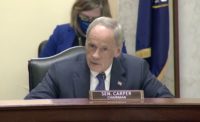A newly proposed six-year Senate highway bill has won praise as a positive step toward a larger goal: a long-term, fully funded surface- transportation measure. But industry officials acknowledge that the next steps on the legislative path will be uphill, especially finding the tens of billions of dollars needed to pay for the program's envisioned higher funding levels.
The Senate Environment and Public Works Committee unanimously approved the bill, dubbed the Developing a Reliable and Innovative Vision for the Economy, or DRIVE, Act, on June 24. Committee Chairman James Inhofe (R-Okla.), the bill's sponsor, said that the six-year bill ncludes an average annual funding increase of 3% over current levels.
The American Road & Transportation Builders Association says the bill's authorizations total $277.4 billion.
Construction industry officials say a key part of the bill is its new National Freight Program, authorized at $13.5 billion over six years, for projects that would speed cargo shipments.
On the downside, the bill cuts the popular TIFIA federal loan program to $675 million a year, from 2014's $1 billion.
Pete Ruane, ARTBA's CEO, says "reliable" is the most important word in the DRIVE bill's title. For several years, construction companies and state highway agencies have endured a series of stopgap authorizations. The latest one expires on July 31.
Ruane says, "If the industry and business community as a whole can rely on steady, growing funding, they will make investments in people [and] equipment." That would mean a greater economic impact than with 2012's MAP-21 law, which spanned 27 months.
The Senate committee has jurisdiction only over highway policy; other panels still must draft titles for transit, safety and—most important—revenue.
Stephen Sandherr, Associated General Contractors of America CEO, says,"It's heavy lifting." But he adds, "There's many reasons to be happy with this bill and to use it as the structure for getting something done."
Story updated on June 24 with committee's approval of the bill. Story updated on June 26 to include ARTBA's calculation of bill's authorizations.


